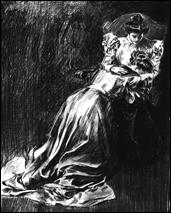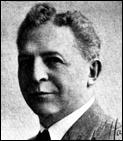The Bomb - First Million-seller
Dominic
Vautier 1/7/2011
Many
a heart is aching,
If you could read them all.[1]
In 1892 an event occurred that had to
greatly influence American music.
A
cheep pop song After
the Ball, exploded upon the public
to become the first million-seller ever. It was followed
immediately that same year by another million-seller, Daisy Bell.
 All
the melee was caused by just this one song, and
was there any way the industry had anticipated its
immense success? Was the song
something special? Was
it so unique that it had to cause such Elvis-type reactions? Was it revolutionary, perhaps a brand new kind of music
altogether? Did it carry
some exotic message? Was it
a wild ragtime song out of the chorus line of Babe Connors[2],
or a rousing jazz number imported right from the French Quarter or a
snappy can-can straight from Paris? Nope. It was none of these.
After
the Ball was nothing more than a second-rate tearjerker slow waltz with a
second-rate melody, like a hundred other tearjerkers that had come
before it. This one,
however, just like Hound
Dog, came along at the right time.
All
the melee was caused by just this one song, and
was there any way the industry had anticipated its
immense success? Was the song
something special? Was
it so unique that it had to cause such Elvis-type reactions? Was it revolutionary, perhaps a brand new kind of music
altogether? Did it carry
some exotic message? Was it
a wild ragtime song out of the chorus line of Babe Connors[2],
or a rousing jazz number imported right from the French Quarter or a
snappy can-can straight from Paris? Nope. It was none of these.
After
the Ball was nothing more than a second-rate tearjerker slow waltz with a
second-rate melody, like a hundred other tearjerkers that had come
before it. This one,
however, just like Hound
Dog, came along at the right time.
Apparently people were ready and the market was
ready. The unfulfilled expectations, the young,
music-hungry consumers were ready, the piano industry, a new purchasing power,
fresh consumerism, rising tide of consumer confidence, and a desire for new types of
entertainment was ready. Conditions
were excellent.
Copies of the song ran out in
New York, Chicago, San Francisco,
Boston,
Philadelphia, and most other cities. The
presses went full steam at Charlie Harris’ publishing house, where the
owners
worked 24 hours a day cranking out sheet music. The song was pirated, as underground publishers joined in .
Harris didn’t mind, since he was busy making a monthly
profit of about $25,000 just from the sale of this one song.[3] That kind of money was considerable then, and Charlie was
more than satisfied with his unexplained and unexpected
success.
.
Harris didn’t mind, since he was busy making a monthly
profit of about $25,000 just from the sale of this one song.[3] That kind of money was considerable then, and Charlie was
more than satisfied with his unexplained and unexpected
success.
The After
the Ball phenomenon was the beginning of a fad. The
Hula-Hoop was a fad too that generated similar enthusiasm.
In both cases a huge opportunity to make a bundle was there, because
the demand was so intense and supply was so limited. The arrival of big time popular music in 1892
looked every bit like another Hula-Hoop type thing, but this fad did not go
away. It just get
bigger and better, and far from going away, not only is it still with
us, it has come to dominate the entire world. In fact, there are very few places left on the globe that have
not been exposed to and seduced by the sounds of that unique contribution to humanity called American popular music.
It has been said that one-third of the world’s population
learned their English from just three songs: Working
for the Yankee Dollar, Sentimental
Journey, and Hound Dog.
[1]
Picture by Charles Dana Gibson, 1898; words from After the Ball by Charles Harris, 1892.
[2]
Babe Connors was a famous night club owner from St. Lewis.
[3]
Jack Burton, The Blue Book of
Tin Pan Alley (New York: Century House, 1951), 36.
 All
the melee was caused by just this one song, and
was there any way the industry had anticipated its
immense success? Was the song
something special? Was
it so unique that it had to cause such Elvis-type reactions? Was it revolutionary, perhaps a brand new kind of music
altogether? Did it carry
some exotic message? Was it
a wild ragtime song out of the chorus line of Babe Connors[2],
or a rousing jazz number imported right from the French Quarter or a
snappy can-can straight from Paris? Nope. It was none of these.
After
the Ball was nothing more than a second-rate tearjerker slow waltz with a
second-rate melody, like a hundred other tearjerkers that had come
before it. This one,
however, just like Hound
Dog, came along at the right time.
All
the melee was caused by just this one song, and
was there any way the industry had anticipated its
immense success? Was the song
something special? Was
it so unique that it had to cause such Elvis-type reactions? Was it revolutionary, perhaps a brand new kind of music
altogether? Did it carry
some exotic message? Was it
a wild ragtime song out of the chorus line of Babe Connors[2],
or a rousing jazz number imported right from the French Quarter or a
snappy can-can straight from Paris? Nope. It was none of these.
After
the Ball was nothing more than a second-rate tearjerker slow waltz with a
second-rate melody, like a hundred other tearjerkers that had come
before it. This one,
however, just like Hound
Dog, came along at the right time. .
Harris didn’t mind, since he was busy making a monthly
profit of about $25,000 just from the sale of this one song.
.
Harris didn’t mind, since he was busy making a monthly
profit of about $25,000 just from the sale of this one song.